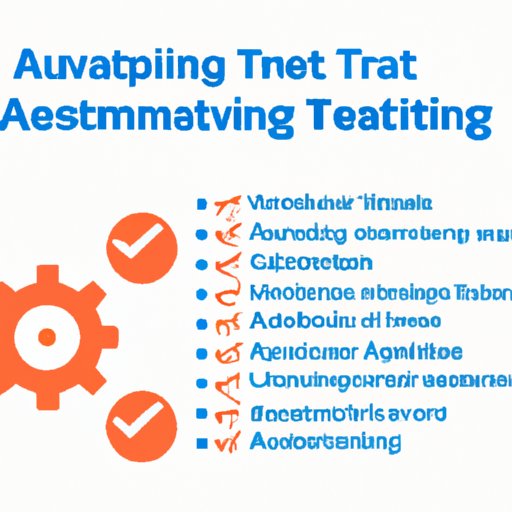Introduction
Software testing has become increasingly important as software applications become more complex and are used by a wide variety of users. Automated testing is one of the most effective ways to ensure that applications meet the quality standards desired by organizations. In this article, we will explore the fundamentals of automated testing, its benefits, how to set it up, advantages and disadvantages, best practices, and its impact on the software development lifecycle (SDLC).
Overview of Automated Testing
Automated testing is a process of executing tests using specialized software tools or scripts to compare the actual outcomes with the expected results. The main purpose of automated testing is to reduce manual effort and increase the speed, accuracy, and reliability of the testing process. Automated testing can be used for both functional and non-functional testing, such as regression testing, unit testing, integration testing, system testing, and acceptance testing. Automated testing also helps improve test coverage and provides accurate and consistent results.
Benefits of Automated Testing
Automated testing offers several key benefits over manual testing. According to a study conducted by Forrester Research, “Organizations that use automated testing can achieve cost savings of up to 70%, faster release cycles, and higher quality software.” Automated testing also increases efficiency, reduces human errors, and improves test accuracy. Additionally, automated tests are easier to maintain and can be executed quickly and repeatedly. This makes it ideal for regression testing, which is critical for ensuring the stability of existing code when making changes.
Setting Up Automated Testing
Setting up automated testing requires careful planning and consideration of the application under test. The first step is to identify the areas of the application that need to be tested and create a test plan. Once the test plan is in place, the next step is to select the appropriate automation tool or framework. There are a variety of open source and commercial solutions available, such as Selenium, Appium, Cucumber, and Robot Framework. It is important to choose the right tool or framework for the job, as each has different features and capabilities.
Types of Automation Testing
There are several different types of automation testing, including unit testing, integration testing, functional testing, system testing, and acceptance testing. Unit testing focuses on individual components of the application, while integration testing focuses on the interactions between components. Functional testing verifies that the application meets the requirements, while system testing verifies the end-to-end functionality of the system. Acceptance testing is the final step and verifies that the application meets the user’s expectations.

Advantages and Disadvantages of Automated Testing
While automated testing offers many benefits, there are some drawbacks as well. One of the primary advantages of automated testing is that it reduces the time required for testing, as tests can be run repeatedly and quickly. Additionally, automated tests are more accurate than manual tests and are less prone to human error. Automated tests are also easier to maintain, as they can be updated quickly and easily.
However, there are some disadvantages to automated testing. Automated tests can be expensive to develop and maintain, as they require specialized knowledge and expertise. Additionally, automated tests can be unreliable if not properly designed, as they may fail to detect certain issues or bugs. Finally, automated tests may not be able to adequately test certain aspects of the application, such as usability or performance.

Best Practices for Automated Testing
In order to maximize the benefits of automated testing, it is important to follow best practices. First, it is important to ensure that automated tests are thoroughly documented and easy to maintain. Additionally, automated tests should be designed to be flexible and modular, as this will make them easier to update and modify. Finally, automated tests should be regularly reviewed to ensure that they are still relevant and that any changes to the application are detected.
Impact of Automated Testing on the Software Development Lifecycle
Automated testing can have a significant impact on the software development lifecycle (SDLC). Automated tests can help identify bugs early in the development process, which can help save time and money. Additionally, automated tests can improve the overall quality of the application, as they can provide more comprehensive coverage than manual tests. Automated tests can also help reduce the time needed for release cycles, as they can be easily repeated and quickly executed.
Manual vs. Automated Testing
When deciding between manual and automated testing, it is important to consider the pros and cons of each approach. Manual testing is typically more time consuming and labor intensive, but it can provide more detailed and accurate results. Automated testing is faster and more efficient, but it can be expensive to set up and maintain. Ultimately, the decision between manual and automated testing will depend on the needs of the organization and the type of application being tested.
Conclusion
Automated testing is a powerful and effective way to ensure the quality and reliability of software applications. Automated testing offers several key benefits, such as cost savings, faster release cycles, and higher quality software. Additionally, automated tests are easier to maintain and can be executed quickly and repeatedly. However, automated tests can be expensive to develop and maintain, and they may not be able to adequately test certain aspects of the application. When deciding between manual and automated testing, it is important to consider the needs of the organization and the type of application being tested.
(Note: Is this article not meeting your expectations? Do you have knowledge or insights to share? Unlock new opportunities and expand your reach by joining our authors team. Click Registration to join us and share your expertise with our readers.)
